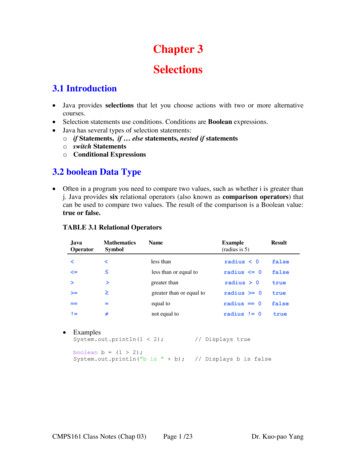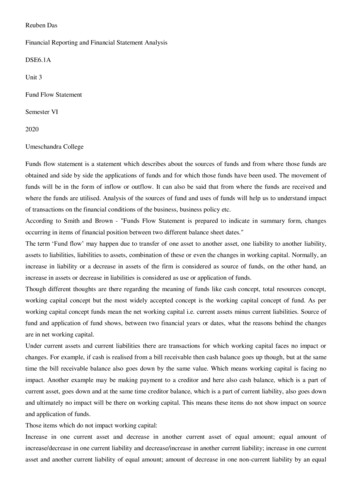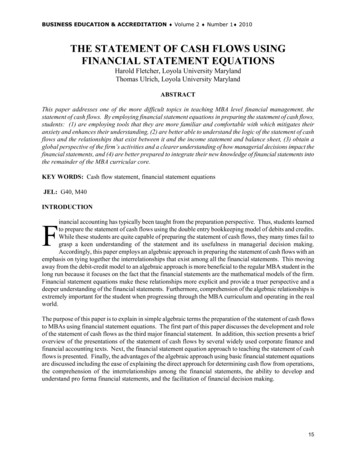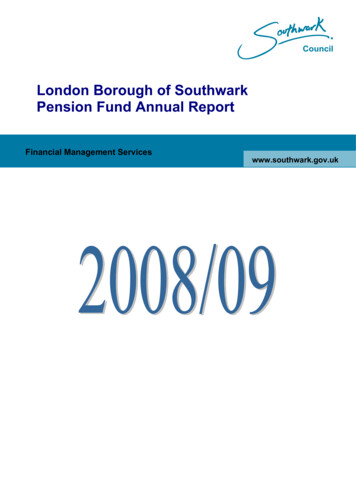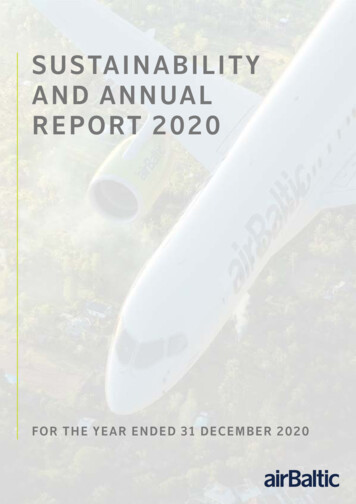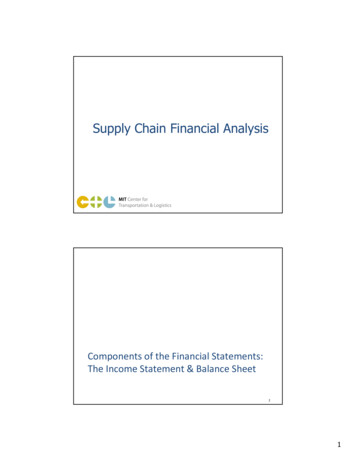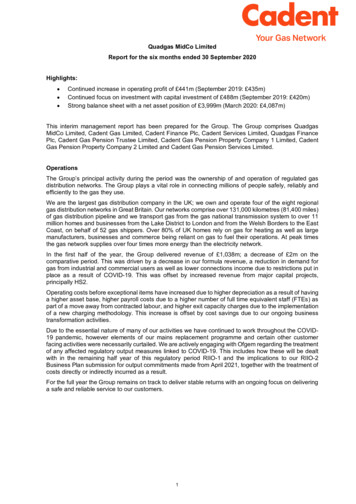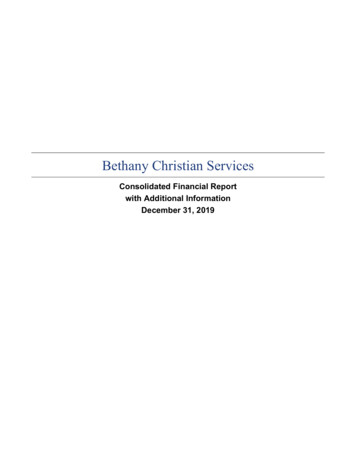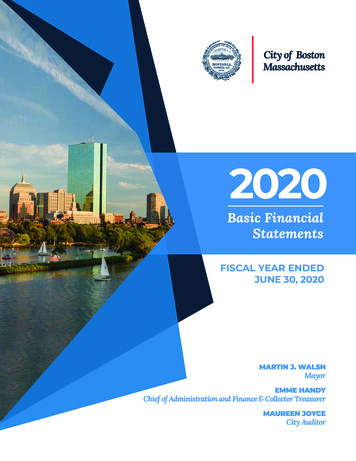
Transcription
2020FISCAL YEAR ENDEDJUNE 30, 2020
Prepared by the City of Boston Auditing Department
City of BostonMassachusettsBasic FinancialStatementsFiscal Year Ended June 30, 2020Martin J. Walsh, MayorEmme Handy, Chief of Administration and Finance & Collector TreasurerMaureen Joyce, City Auditor
FINANCIAL SECTIONIndependent Auditors’ Report A-1Management’s Discussion and Analysis (Unaudited) A-3Basic Financial Statements:TABLE OFCONTENTSGOVERNMENT-WIDE FINANCIAL STATEMENTSStatement of Net Position A-15Statement of Activities A-17FUND FINANCIAL STATEMENTSBalance Sheet – Governmental Funds A-19Reconciliation of the Balance Sheet of the Governmental Funds to theStatement of Net Position A-20Statement of Revenues, Expenditures, and Changes in Fund Balances –Governmental Funds A-21Reconciliation of the Statement of Revenues, Expenditures, and Changes inFund Balance of Governmental Funds to the Statement of Activities A-22Statement of Revenues and Expenditures – Budgetary Basis, General Fund –Budget and Actual A-23Statement of Net Position – Proprietary Fund A-24Statement of Revenues, Expenses, and Changes in Net Position –Proprietary Fund A-25Statement of Cash Flows – Proprietary Fund A-26Statement of Fiduciary Net Position – Fiduciary Funds A-27Statement of Changes in Fiduciary Net Position – Fiduciary Funds A-28Notes to the Basic Financial Statements A-29Required Supplementary Information (Unaudited):Schedules of OPEB Contributions A-68Schedules of Changes in Net OPEB Liability A-69Schedule of City’s Proportionate Share of the Net Pension Liability – BostonRetirement System A-70Schedule of City’s Contributions – Boston Retirement System A-70City of BostonBasic Financial Statements Fiscal Year Ended June 30, 2020
Financial Section INDEPENDENT AUDITORS’ REPORTKPMG LLPTwo Financial Center60 South StreetBoston, MA 02111Independent Auditors’ ReportTo the Honorable Mayor and City CouncilCity of Boston, Massachusetts:Report on the Financial StatementsWe have audited the accompanying financial statements of the governmental activities, the aggregatediscretely presented component units, each major fund, and the aggregate remaining fund information of theCity of Boston, Massachusetts (the City), as of and for the year ended June 30, 2020, and the related notes tothe financial statements, which collectively comprise the City’s basic financial statements as listed in the tableof contents.Management’s Responsibility for the Financial StatementsManagement is responsible for the preparation and fair presentation of these financial statements inaccordance with U.S. generally accepted accounting principles; this includes the design, implementation, andmaintenance of internal control relevant to the preparation and fair presentation of financial statements that arefree from material misstatement, whether due to fraud or error.Auditors’ ResponsibilityOur responsibility is to express opinions on these financial statements based on our audit. We did not audit thefinancial statements of the Dudley Square Realty Corporation, the Ferdinand Building DevelopmentCorporation, and the City’s Permanent Funds, which represent 3.7% and 0.2% of the assets and revenues ofthe governmental activities, respectively, and 0.9% and 0.4% of the assets and revenues of the aggregateremaining fund information, respectively. We also did not audit the financial statements of the BostonRetirement System and the City's OPEB Trust Fund and Private-Purpose Trust Funds, which represent 97.4%and 86.7% of the assets and revenues of the aggregate remaining fund information, respectively. Further, wedid not audit the financial statements of the Boston Public Health Commission, Trustees of the Public Library ofthe City of Boston and the Economic Development and Industrial Corporation of Boston, which represent58.1% and 89.7% of the assets and revenues of the aggregate discretely presented component units,respectively. Those financial statements were audited by other auditors whose report has been furnished to us,and our opinions, insofar as they relate to the amounts included for those entities, is based solely on the reportsof the other auditors. We conducted our audit in accordance with auditing standards generally accepted in theUnited States of America and the standards applicable to financial audits contained in Government AuditingStandards, issued by the Comptroller General of the United States. Those standards require that we plan andperform the audit to obtain reasonable assurance about whether the financial statements are free from materialmisstatement.An audit involves performing procedures to obtain audit evidence about the amounts and disclosures in thefinancial statements. The procedures selected depend on the auditors’ judgment, including the assessment ofthe risks of material misstatement of the financial statements, whether due to fraud or error. In making thoserisk assessments, the auditor considers internal control relevant to the entity’s preparation and fair presentationof the financial statements in order to design audit procedures that are appropriate in the circumstances, butnot for the purpose of expressing an opinion on the effectiveness of the entity’s internal control. Accordingly, weexpress no such opinion. An audit also includes evaluating the appropriateness of accounting policies used andKPMG LLP, a Delaware limited liability partnership and a member firm ofthe KPMG global organization of independent member firms affiliated withKPMG International Limited, a private English company limited by guarantee.A-1City of BostonBasic Financial Statements Fiscal Year Ended June 30, 2020
Financial Section INDEPENDENT AUDITORS’ REPORTthe reasonableness of significant accounting estimates made by management, as well as evaluating the overallpresentation of the financial statements.We believe that the audit evidence we have obtained is sufficient and appropriate to provide a basis for ouraudit opinions.OpinionsIn our opinion, based on our audit and the reports of the other auditors, the financial statements referred toabove present fairly, in all material respects, the respective financial position of the governmental activities, theaggregate discretely presented component units, each major fund, and the aggregate remaining fundinformation of the City, as of June 30, 2020, and the respective changes in financial position and, whereapplicable, cash flows thereof and the budgetary comparison for the City’s General Fund for the year thenended in accordance with U.S. generally accepted accounting principles.Other MattersPrior-Year Comparative InformationThe financial statements include partial prior-year comparative information related to the budgetary comparisonfor the City's General Fund. Such information does not include all of the information required for a presentationin conformity with U.S. generally accepted accounting principles. Accordingly, such information should be readin conjunction with the City's financial statements for the year ended June 30, 2019, from which such partialinformation was derived.Required Supplementary InformationU.S. generally accepted accounting principles require that the management’s discussion and analysis andschedules listed under the Required Supplementary Information in the table of contents be presented tosupplement the basic financial statements. Such information, although not a part of the basic financialstatements, is required by the Governmental Accounting Standards Board who considers it to be an essentialpart of financial reporting for placing the basic financial statements in an appropriate operational, economic, orhistorical context. We and other auditors have applied certain limited procedures to the required supplementaryinformation in accordance with auditing standards generally accepted in the United States of America, whichconsisted of inquiries of management about the methods of preparing the information and comparing theinformation for consistency with management’s responses to our inquiries, the basic financial statements, andother knowledge we obtained during our audit of the basic financial statements. We do not express an opinionor provide any assurance on the information because the limited procedures do not provide us with sufficientevidence to express an opinion or provide any assurance.Other Reporting Required by Government Auditing StandardsIn accordance with Government Auditing Standards, we have also issued our report dated January 28, 2021 onour consideration of the City’s internal control over financial reporting and on our tests of its compliance withcertain provisions of laws, regulations, contracts, and grant agreements and other matters. The purpose of thatreport is solely to describe the scope of our testing of internal control over financial reporting and complianceand the results of that testing, and not to provide an opinion on the effectiveness of the City’s internal controlover financial reporting or on compliance. That report is an integral part of an audit performed in accordancewith Government Auditing Standards in considering the City’s internal control over financial reporting andcompliance.Boston, MassachusettsJanuary 28, 2021City of BostonBasic Financial Statements Fiscal Year Ended June 30, 2020A-2
Financial Section MANAGEMENT’S DISCUSSION AND ANALYSISMANAGEMENT’S DISCUSSION AND ANALYSIS(Unaudited)The City of Boston (the City) provides this Management’s Discussion and Analysis to present additional information to thereaders of the City’s basic financial statements. This narrative overview and analysis of the financial activities of the City is forthe fiscal year ended June 30, 2020. Readers are encouraged to consider this information in conjunction with the additionalinformation that is furnished in the City’s Comprehensive Annual Financial Report (CAFR).OVERVIEW OF THE FINANCIAL STATEMENTSThis discussion and analysis is intended to serve as an introduction to the City’s financial statements. The City’s basic financialstatements include three components: 1) Government-wide Financial Statements, 2) Fund Financial Statements, and 3)Notes to the Financial Statements. This report also contains required supplementary information regarding historical pensioninformation and other postemployment benefit (OPEB) plan information. The components of the financial statements aredescribed in the following sections.Basic Financial StatementsThe basic financial statements include two types of financial statements that present different views of the City – the Governmentwide Financial Statements and the Fund Financial Statements. The Notes to the Basic Financial Statements supplement thefinancial statement information and clarify line items that are part of the financial statements.Government-wide Financial StatementsThe Government-wide Financial Statements provide a broad view of the City’s operations in a manner similar to a privatesector business. The statements provide both short-term and long-term information about the City’s financial position, whichassists in assessing the City’s economic condition at the end of the fiscal year. These are prepared using the economic resourcesmeasurement focus and the accrual basis of accounting. This basically means they follow methods that are similar to thoseused by most businesses. They take into account all revenues and expenses connected with the fiscal year even if cash involvedhas not been received or paid. The Government-wide Financial Statements include two statements: The Statement of Net Position presents all of the government’s assets and deferred outflows of resources and liabilitiesand deferred inflows of resources, with the difference between them reported as net position. Over time, increasesor decreases in the City’s net position may serve as a useful indicator of whether the financial position of the City isimproving or deteriorating. The Statement of Activities presents information showing how the government’s net position changed during the mostrecent fiscal year. All changes in net position are reported as soon as the underlying event giving rise to the changeoccurs, regardless of the timing of related cash flows. Thus, revenues and expenses are reported in this statementfor some items that will not result in cash flows until future fiscal periods (such as uncollected taxes and earned butunused vacation leave). This statement also presents a comparison between direct expenses and program revenuesfor each function of the City.Both the above financial statements present two separate sections as described below. Governmental Activities – The activities in this section are mostly supported by taxes and intergovernmental revenues(federal and state grants). Most services normally associated with city government fall into this category, includinggeneral government, human services, public safety, public works, property and development, parks and recreation,library, schools, public health programs, state and district assessments, and debt service. Discretely Presented Component Units – These are legally separate entities for which the City has financial accountabilitybut function independent of the City. For the most part, these entities operate similar to private sector businesses. TheCity’s four discretely presented component units are the Boston Public Health Commission, the Boston Development& Planning Agency, the Economic Development Industrial Corporation, and the Trustees of the Boston Public Library.A-3City of BostonBasic Financial Statements Fiscal Year Ended June 30, 2020
Financial Section MANAGEMENT’S DISCUSSION AND ANALYSISComplete financial statements of the individual component units can be obtained from their respective administrative offices.Additional information about the City’s component units is presented in the Notes to the Financial Statements.The Government-wide Financial Statements can be found immediately following this discussion and analysis.Fund Financial StatementsA fund is a grouping of related accounts that is used to maintain control over resources that have been segregated for specificactivities or objectives. The City, like other local governments, uses fund accounting to ensure and demonstrate compliancewith finance-related legal requirements.The Fund Financial Statements focus on individual parts of the City government, reporting the City’s operations in moredetail than the Government-wide Financial Statements. All of the funds of the City can be divided into three categories. It isimportant to note that these fund categories use different accounting approaches and should be interpreted differently. Thethree categories of funds are:Governmental Funds – Most of the basic services provided by the City are financed through governmental funds. Governmentalfunds are used to account for essentially the same functions reported as governmental activities in the Government-wideFinancial Statements. However, unlike the Government-wide Financial Statements, the Governmental Fund Financial Statementsfocus on near term inflows and outflows of spendable resources. They also focus on the balances of spendable resourcesavailable at the end of the fiscal year. Such information may be useful in evaluating the government’s near term financingrequirements. This approach is known as using the flow of current financial resources measurement focus and the modifiedaccrual basis of accounting. Under this approach, revenues are recorded when cash is received or when susceptible to accrual(i.e., measurable and available to liquidate liabilities of the current period). Expenditures are generally recorded when liabilitiesare incurred, except for those related to long-term liabilities, which are recorded when due and payable. These statementsprovide a detailed short term view of the City’s finances to assist in determining whether there will be adequate financialresources available to meet the current needs of the City.Because the focus of governmental funds is narrower than that of the Government-wide Financial Statements, it is useful tocompare the information presented for governmental funds with similar information presented for governmental activities in theGovernment-wide Financial Statements. By doing so, readers may better understand the long term impact of the government’snear term financing decisions. Both the governmental fund balance sheet and the governmental fund statement of revenues,expenditures, and changes in fund balances provide a reconciliation to facilitate this comparison between governmental fundsand the governmental activities. These reconciliations are presented on the page immediately following each governmentalfund financial statement.The City presents four columns in the governmental fund balance sheet and in the governmental fund statement of revenues,expenditures, and changes in fund balances. The City’s three major governmental funds are the General Fund, the SpecialRevenue Fund, and the Capital Projects Fund. All non-major governmental funds are combined in the “Other GovernmentalFunds” column on these statements. The Governmental Fund Financial Statements can be found immediately following theGovernment-wide Financial Statements.Of the City’s governmental funds, the General Fund is the only fund for which a budget is legally adopted. The Statement ofRevenues and Expenditures – Budgetary Basis is presented after the governmental fund financial statements. This statementprovides a comparison of the General Fund original and final budget and the actual expenditures for the current and prioryear on a budgetary basis.In accordance with state law and regulations, the City’s legally adopted General Fund budget is prepared on a “budgetary”basis instead of U.S. generally accepted accounting principles (GAAP). Among the key differences between these two sets ofaccounting principles are that “budgetary” records property tax as it is levied, while GAAP records it as it becomes susceptibleto accrual, “budgetary” records certain activities and transactions in the General Fund that GAAP records in separate funds,and “budgetary” records any amount raised to cover a prior year deficit as an expenditure and any available funds raisedfrom prior year surpluses as a revenue, while GAAP ignores these impacts from prior years. The difference in accountingprinciples inevitably leads to varying results in excess or deficiency of revenues over expenditures. Additional information anda reconciliation of “budgetary” to GAAP statements is provided in note 4 to the Financial Statements.City of BostonBasic Financial Statements Fiscal Year Ended June 30, 2020A-4
Financial Section MANAGEMENT’S DISCUSSION AND ANALYSISProprietary Funds – These funds are used to show activities that operate more like those of commercial enterprises. Like theGovernment-wide Financial Statements, Proprietary Fund Financial Statements use the economic resources measurementfocus and accrual basis of accounting. There are two types of proprietary funds – enterprise funds and internal service funds.Enterprise funds charge fees for services provided to outside customers including local governments. Enterprise Funds providethe same type of information as the business-type activities of the Government-wide Financial Statements within governmentalactivities, only in more detail. Currently, the City does not have any enterprise funds. The Internal Service Fund provides healthinsurance services predominantly to other funds, departments or agencies of the City. Therefore, its activities are included inthe Government-wide financial statements within governmental activities.The Proprietary Funds Financial Statements can be found immediately following the Governmental Fund Financial Statements.Fiduciary Funds – These funds are used to account for resources held for the benefit of parties outside the City government.Fiduciary funds are not reflected in the Government-wide Financial Statements because the resources of these funds are notavailable to support the City’s own programs. The accounting used for fiduciary funds is much like that used for proprietaryfunds. They use the economic resources measurement focus and accrual basis of accounting.The City’s fiduciary funds are the Employee Retirement Fund (the Boston Retirement System), which accounts for thetransactions, assets, liabilities, and net position of the City employees’ pension plan; the Other Postemployment Benefits(OPEB) Trust Fund, which is an irrevocable trust established for the accumulation of assets to reduce the liability associatedwith the City’s obligation for other postemployment benefits; and the Private Purpose Trust and Agency Funds, which includemoney held and administered by the City on behalf of third parties.The Fiduciary Funds Financial Statements can be found immediately following the Proprietary Fund Financial Statements.Notes to the Financial StatementsThe notes provide additional information that is essential to a full understanding of the data provided in the Government-wideand the Fund Financial Statements. The Notes to the Financial Statements can be found immediately following the FiduciaryFunds Financial Statements.Required Supplementary InformationThe basic financial statements are followed by a section of required supplementary information, which includes a schedule offunding progress and a schedule of employer contributions for the OPEB Trust Fund, a schedule of changes in net OPEB liabilityand related ratios, a schedule of the City’s proportionate share of the net pension liability of the Boston Retirement System,and a schedule of the City’s contributions to the Boston Retirement System.CURRENT YEAR FINANCIAL IMPACTS The City of Boston’s OPEB obligation significantly impacts the Government-wide financial results. The most recentvaluation of the City’s OPEB obligation as of June 30, 2019, estimated that the total OPEB liability of the City decreasedby 142.1 million to 2.3 billion. This decrease was largely a result of changes of benefit terms and changes inassumptions. In fiscal year 2020, the City’s contribution to the OPEB Trust Fund ( 169.9 million) for retiree health benefits includes 40.0 million in advance funding toward reducing the OPEB liability. The Actuarially Determined Contribution (ADC)was not met in 2020. In fiscal year 2021, the City has also appropriated 40.0 million in advance funding towardreducing the OPEB liability. The City of Boston’s net pension liability significantly impacts the Government-wide financial results. The City isrequired to report its proportionate share of the collective net pension liability, deferred outflows of resources,deferred inflows of resources, and pension expense. Based on the measurement of the Boston Retirement System’snet pension liability as of December 31, 2019, the City’s proportionate share of that net pension liability decreasedby 142.1 million and the net pension liability for the City’s non contributory plan as of June 30, 2020 increased by 23.8 million resulting in a total net pension liability of 1.75 billion.A-5City of BostonBasic Financial Statements Fiscal Year Ended June 30, 2020
Financial Section MANAGEMENT’S DISCUSSION AND ANALYSISGOVERNMENT-WIDE FINANCIAL ANALYSISThis analysis is based on the Statement of Net Position and the Statement of Activities found directly after Management’sDiscussion and Analysis.Government-wide HighlightsNet Position – Primary Government – The total liabilities and deferred inflows of resources of the City exceeded its assets anddeferred outflows of resources at fiscal year ended June 30, 2020 in a net deficit of 1.16 billion (presented as net position).At year end, the City had a deficit in governmental activities unrestricted net position in the amount of 2.18 billion.Changes in Net Position – Primary Government – The City’s total net position decreased by 613.8 million from the amountreported in fiscal year 2019.Net PositionAs noted earlier, net position may serve over time as a useful indicator of a government’s financial position. The City’s net deficittotaled 1.16 billion at the end of 2020, compared to a net deficit of 1.77 billion reported at the end of the previous year.The components of net position comprise the following: the investment in capital assets such as land, buildings, equipment,and infrastructure (road, bridges, and other immovable assets), less any related debt used to acquire those assets that are stilloutstanding – this amount is 950.1 million indicating that the net book value of the City’s capital assets exceeds the amountof related capital debt outstanding. The City uses these capital assets to provide services to citizens; consequently, these assetsare not available for future spending. Although the City’s investment in its capital assets is reported net of related debt, itshould be noted that the resources needed to repay this debt must be provided from other sources, since the capital assetsthemselves cannot be used to liquidate these liabilities.A portion of the City’s governmental activities net position, 72.4 million, represents restricted net position, or resources thatare subject to external restrictions on how they may be used. Internally imposed designations of resources are not presentedas restricted net assets. The unrestricted net position decreased by 491.8 million from the 2019 amount of 2.68 billion.City of BostonBasic Financial Statements Fiscal Year Ended June 30, 2020A-6
Financial Section MANAGEMENT’S DISCUSSION AND ANALYSISNet Position – Primary Government(In thousands)Governmental ActivitiesTotal Primary Government20202019ASSETS:Current assets 2,254,988 2,180,472Capital assets 2,332,075 2,234,836Other assets 228,315 205,493 4,815,378 4,620,801 711,559 495,090Current liabilities 878,455 753,318Noncurrent liabilities 5,640,215 5,971,222Total assetsDEFERRED OUTFLOWS OF RESOURCES:Total deferred outflows of resourcesLiabilities: 6,518,670 6,724,540 169,126 165,996Net investment in capital assets 950,089 Restricted 72,436 98,106Unrestricted (2,183,384) (2,675,142)Total liabilitiesDEFERRED INFLOWS OF RESOURCES:Total deferred inflows of resourcesNET POSITION:Total net positionA-7City of BostonBasic Financial Statements Fiscal Year Ended June 30, 2020802,391 (1,160,859) (1,774,645)
Financial Section MANAGEMENT’S DISCUSSION AND ANALYSISChanges in Net Position – Primary Government(In thousands)Governmental ActivitiesTotal Primary Government20202019Revenues:Program revenues:Charges for services305,892 235,996Operating grants and contributions 788,801 822,932Capital grants and contributions 38,382 36,224Taxes 2,834,165 2,690,228Grants and contributions not restricted 245,559 208,839Investment income 43,280 46,405Miscellaneous 3,109 3,011Special item - gain on sale of property - 57,000 4,259,188 4,100,635General government 202,347 Human services 47,648 57,359Public safety 968,853 1,113,749Public works 161,598 160,918Property and development 140,930 146,886Parks and recreation 52,148 48,804Library 51,348 55,944Schools 1,874,077 2,026,241Public health programs 99,414 91,468Interest on long-term debt 47,039 39,562General revenues:Total revenuesProgram expenses:175,161Total program expenses 3,645,402 3,916,092Change in net position 613,786 184,543Net position - beginning of yearNet position-end of year (1,774,645) (1,959,188) (1,160,859) (1,774,645) City of BostonBasic Financial Statements Fiscal Year Ended June 30, 2020A-8
Financial Section MANAGEMENT’S DISCUSSION AND ANALYSISGovernmental ActivitiesThe City’s governmental activities net position increased by 613.8 million over the prior fiscal year. The following net changesoccurred during the course of operations in fiscal year 2020. In the assets accounts, cash and investments increased by 74.5million, receivables decreased by 4.4 million, and capital assets increased by 97.2 million. In the liability accounts, there wasa decrease in warrants and accounts payable of 8.0 million and an increase in accrued liabilities by 24.1 million. Additionally,a decrease of 142.1 million was recorded relative to the City’s other postemployment benefit obligation and a decrease of 2.8 million was recorded relative to the City’s net pension liability in 2020.During fiscal year 2020, the City’s revenues increased by 3.9%. The City’s largest sources of revenues were property taxes, excisetaxes, and payment in lieu of taxes of 2.83 billion (66.5% of total revenues) and 1.13
did not audit the financial statements of the Boston Public Health Commission, Trustees of the Public Library of the City of Boston and the Economic Development and Industrial Corporation of Boston, which represent 58.1% and 89.7% of the assets and revenues of the aggregate discretely presented component units, respectively.
